
Theodor Seuss Geisel was an American children's author and cartoonist. He is known for his work writing and illustrating more than 60 books under the pen name Dr. Seuss. His work includes many of the most popular children's books of all time, selling over 600 million copies and being translated into more than 20 languages by the time of his death.
A non-Newtonian fluid is a fluid that does not follow Newton's law of viscosity, that is, it has variable viscosity dependent on stress. In particular, the viscosity of non-Newtonian fluids can change when subjected to force. Ketchup, for example, becomes runnier when shaken and is thus a non-Newtonian fluid. Many salt solutions and molten polymers are non-Newtonian fluids, as are many commonly found substances such as custard, toothpaste, starch suspensions, corn starch, paint, blood, melted butter, and shampoo.
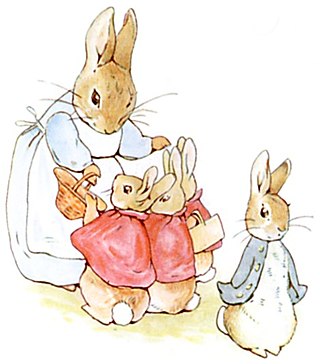
A picture book combines visual and verbal narratives in a book format, most often aimed at young children. With the narrative told primarily through text, they are distinct from comics, which do so primarily through sequential images.
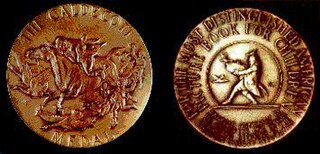
The Randolph Caldecott Medal, frequently shortened to just the Caldecott, annually recognizes the preceding year's "most distinguished American picture book for children". It is awarded to the illustrator by the Association for Library Service to Children (ALSC), a division of the American Library Association (ALA). The Caldecott and Newbery Medals are considered the most prestigious American children's book awards. Beside the Caldecott Medal, the committee awards a variable number of citations to runners-up they deem worthy, called the Caldecott Honor or Caldecott Honor Books.
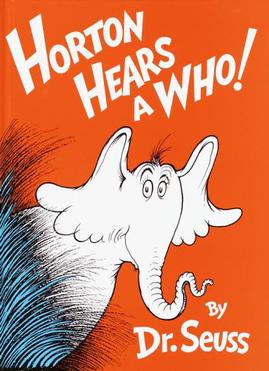
Horton Hears a Who! is a children's book written and illustrated by Theodor Seuss Geisel under the pen name Dr. Seuss. It was published in 1954 by Random House. This book tells the story of Horton the Elephant and his adventures saving Whoville, a tiny planet located on a speck of dust, from the animals who mock him. These animals attempt to steal and burn the speck of dust, so Horton goes to great lengths to save Whoville from being incinerated.
James W. Kemp was a United Methodist pastor and author from Lexington, Kentucky. He is best known for his book The Gospel According to Dr. Seuss.

The 500 Hats of Bartholomew Cubbins is a children's book, written and illustrated by Theodor Geisel under the pen name Dr. Seuss and published by Vanguard Press in 1938. Unlike the majority of Geisel's books, it is written in prose rather than rhyming and metered verse. Geisel, who collected hats, got the idea for the story on a commuter train from New York to New England, while he was sitting behind a businessman wearing a hat; the passenger was so stiff and formal that Geisel idly wondered what would happen if he took the man's hat and threw it out the window. Geisel concluded that the man was so "stuffy" that he would just grow a new one.
Leo Dillon and Diane Dillon were American illustrators of children's books and adult paperback book and magazine covers. One obituary of Leo called the work of the husband-and-wife team "a seamless amalgam of both their hands". In more than 50 years, they created more than 100 speculative fiction book and magazine covers together as well as much interior artwork. Essentially all of their work in that field was joint.

The Wubbulous World of Dr. Seuss is an American children's puppet television series based on characters created by Dr. Seuss, produced by The Jim Henson Company. It aired from October 13, 1996, to May 15, 1998, on Nickelodeon. It combines live puppets with digitally animated backgrounds, and in its first season, refashioning characters and themes from the original Dr. Seuss books into new stories that often retained much of the flavor of Dr. Seuss' own works.

And to Think That I Saw It on Mulberry Street is Theodor Seuss Geisel's first children's book published under the name Dr. Seuss. First published by Vanguard Press in 1937, the story follows a boy named Marco, who describes a parade of imaginary people and vehicles traveling along a road, Mulberry Street, in an elaborate fantasy story he dreams up to tell his father at the end of his walk. However, when he arrives home, he decides instead to tell his father what he actually saw—a simple horse and wagon.

Yertle the Turtle and Other Stories is a picture book collection by Theodor Seuss Geisel, published under his more commonly known pseudonym of Dr. Seuss. It was first released by Random House Books on April 12, 1958, and is written in Seuss's trademark style, using a type of meter called anapestic tetrameter. Though it contains three short stories, it is mostly known for its first story, "Yertle the Turtle", in which the eponymous Yertle, king of the pond, stands on his subjects in an attempt to reach higher than the Moon—until the bottom turtle burps and he falls into the mud, ending his rule.

Mo Willems is an American writer, animator, voice actor, and children's book author. His work includes creating the animated television series Sheep in the Big City for Cartoon Network, working on Sesame Street and The Off-Beats, and creating the popular children's book series Elephant and Piggie.
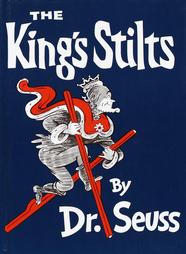
The King's Stilts is a children's book written and illustrated by Theodor Geisel, under the pen name Dr. Seuss, and first published in 1939 by Random House. Unlike many Dr. Seuss books, it is narrated in prose rather than verse.

McElligot's Pool is a children's book written and illustrated by Theodor Geisel under the pen name Dr. Seuss and published by Random House in 1947. In the story, a boy named Marco, who first appeared in Geisel's 1937 book And to Think That I Saw It on Mulberry Street, imagines a wide variety of fantastic fish that could be swimming in the pond in which he is fishing. It later became one of the Seuss books featured in the Broadway musical Seussical where its story is used for the song "It's Possible".

Many Moons is an American children's picture book written by James Thurber and illustrated by Louis Slobodkin. It was published by Harcourt, Brace & Company in 1943 and won the Caldecott Medal in 1944. The book centers around a young girl, Princess Lenore, who becomes ill, and only one thing will make her better: the Moon. The book was Thurber's first picture book.
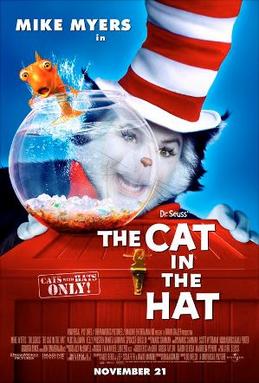
The Cat in the Hat is a 2003 American fantasy comedy film directed by Bo Welch in his directorial debut and written by Alec Berg, David Mandel and Jeff Schaffer. Loosely based on Dr. Seuss's 1957 book of the same name, it was the second and final live-action feature-length Dr. Seuss adaptation after How the Grinch Stole Christmas (2000). The film stars Mike Myers in the title role along with Alec Baldwin, Kelly Preston, Dakota Fanning, Spencer Breslin, Amy Hill and Sean Hayes in supporting roles.
Uri Shulevitz is an American writer and illustrator of children's books. He won the 1969 Caldecott Medal for U.S. picture book illustration, recognizing The Fool of the World and the Flying Ship, an Eastern European fairy tale retold by Arthur Ransome in 1916.
Bartholomew Cubbins is a fictional page and the hero of two children's books by Dr. Seuss: The 500 Hats of Bartholomew Cubbins (1938) and Bartholomew and the Oobleck (1949). Cubbins also appears in "King Grimalken and the Wishbones", the first of Seuss's so-called "lost stories" that were only published in magazines. Besides the three printed stories about him—and the stage adaptations of both books—Bartholomew Cubbins also appears as a character in the TV show The Wubbulous World of Dr. Seuss. Seuss's only film, The 5,000 Fingers of Dr. T., has a main character named Bartholomew Collins who is based on Cubbins, and, like his namesake, is a young boy who is wiser than the adults around him.

The Stray Dog is a 2000 children's picture book by Marc Simont, the recipient of the Caldecott Honor in 2001. Published by Harper Collins Publishers, this was Simont's second Caldecott Honor, after The Happy Day by Ruth Krauss in 1950.

The Lorax is a 2012 American animated musical fantasy comedy film produced by Illumination Entertainment and distributed by Universal Pictures. It is the second screen adaptation of Dr. Seuss' 1971 children's book of the same name following the 1972 animated television special. It was directed by Chris Renaud, co-directed by Kyle Balda, and produced by Chris Meledandri and Janet Healy, from a screenplay written by the writing team of Cinco Paul and Ken Daurio. Paul and Daurio also served as executive producers alongside Dr. Seuss' widow Audrey Geisel. Starring the voices of Danny DeVito, Ed Helms, Zac Efron, Taylor Swift, Rob Riggle, Jenny Slate, and Betty White, the film builds on the book by expanding the story of the Lorax and Ted, the previously unnamed boy who visits the Once-ler.















